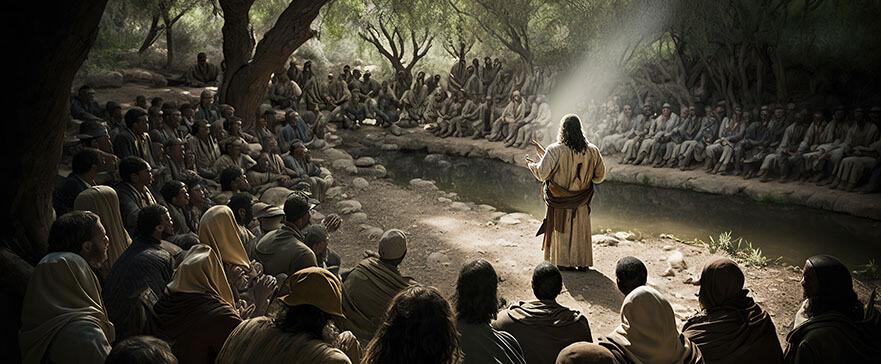The book of Matthew is the most Jewish of the four Gospel accounts of Jesus’ earthly ministry. You can only fully appreciate Jesus’ miracles in Matthew if you pay attention to the Old Testament context and the culture of 1st-century Jerusalem. The Jews knew the ancient prophecies regarding the Messiah; so Matthew linked Christ’s actions to the Old Testament background and Jewish expectations of the Messiah.
Let’s analyze how Jesus’ ministry in the Gospel of Matthew proves He is the promised Messiah.
His Birth
The Jews knew where the Messiah would be born. We see this clearly in Matthew 2 when the wise men came to Jerusalem and asked, “Where is He who has been born King of the Jews?” (v. 2). Feeling troubled, King Herod summoned chief priests and scribes who revealed Christ must have been in Bethlehem. You can imagine the priests and scribes rushing to open an ancient scroll of the prophet Micah and pointing to the words confirming the Messiah’s birthplace was to be Bethlehem of Ephrathah.
The prophecy in Micah is even more remarkable when we understand that there were two Bethlehems in ancient Israel. The books of Joshua and Judges reference a town called Bethlehem located in the historical territory of the tribe of Zebulun in northern Israel. The Jews knew it was not the Bethlehem of Zebulun but the tiny town of Bethlehem in the Judaean Hills five miles south of Jerusalem. Herod knew it also, so he concentrated his massacre of infant boys in Bethlehem in the territory of Judah. The Messiah could not be born in a different place; and despite significant opposition, Jesus was finally born in Bethlehem.
The Abundance of Miracles
The Jewish people expected the Messiah to perform miracles to authenticate His message. The Gospel of Matthew records many of Jesus’ miraculous acts to strengthen His Messianic claim. Jesus cleansed the lepers (8:2–4), healed the lame (9:1–8), gave sight to the blind (vv. 27–30), and cast out demons that made people deaf and mute (vv. 32–33).
These impressive miracles showed Jesus’ power, but they also corresponded to prophecies in the Tanakh (Hebrew Bible). Matthew 11 records John the Baptist sending his disciples to ask Jesus if he is the Coming One. Jesus responded by alluding to the prophecy in Isaiah 35:5–6:
Then the eyes of the blind shall be opened, and the ears of the deaf shall be unstopped; then the lame shall leap like a deer, and the tongue of the dumb sing. For waters shall burst forth in the wilderness, and streams in the desert.
Jesus, by saying to John’s disciples, “go and tell John the things which you hear and see” (v. 4), performed the specific miracles Scripture attributed to the promised Messiah.
Therefore, Jesus, by saying to John’s disciples, “go and tell John the things which you hear and see” (v. 4), performed the specific miracles Scripture attributed to the promised Messiah.
The Messianic Miracles
Jesus performed many miracles the rabbis classified as “Messianic miracles,” remarkable wonders only the Messiah could perform. Jesus performed a particularly noteworthy Messianic miracle when He healed a leper (Matthew 8:2–4; Mark 1:40–45; Luke 5:12–16).
Leprosy, also known as Hansen’s disease, is a chronic bacterial infection. It primarily affects the skin and nerves and can lead to symptoms including skin lesions, numbness or loss of sensation in affected areas, and muscle weakness.
In the Bible, leprosy was seen as a serious and contagious disease; and those who were afflicted with it were often ostracized from society and required to live outside of towns and cities.
The book of Leviticus provides detailed instructions for identifying and treating cases of leprosy (Leviticus 13—14). It also describes the rituals that were performed to cleanse someone who had been healed of the disease. In Matthew 8:2–4, Jesus instructed the healed leper to talk to no one but to go straight to the priests “and offer the gift Moses commanded, as a testimony to them.” The priests, therefore, would have to investigate this miracle and activate a procedure of declaring someone clean from leprosy.
Though Miriam was previously healed of leprosy and Naaman the Syrian commander was healed but was not Jewish, this event is the first time the Bible records that a Jewish person was healed of leprosy since the completion of the Mosaic Law. The Jewish priests could not ignore this miracle but had to follow the instructions that would force them to acknowledge that Jesus performed a Messianic miracle.
The Response Is Key
Despite Jesus’ remarkable ministry on Earth full of wonders and miracles, most Jewish leaders chose not to accept Him as the Messiah. However, many other Jewish people trusted Him, and their lives were changed forever. Both groups saw the same miracles, but only one believed in Him. Jesus fulfilled the Old Testament prophecies by performing miracles only the Messiah could do. He did not do so to impress people but to show He is humanity’s only salvation.





Comments 1
Now I understand why the healed lepers were sent to the priests for cleansing. The prests could then no longer ignore Jesus’ identity or mission as the Messiah. Thank you.